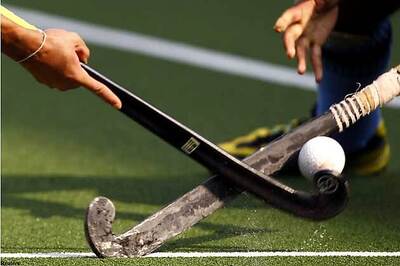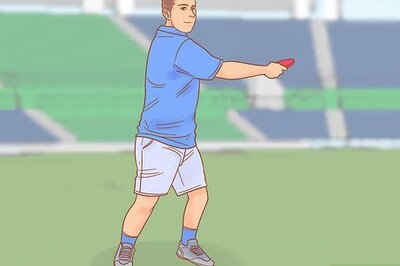
views
Barcelona: Lionel Messi's remarkable career with Barcelona began on a napkin.
It happened more than a decade ago, when the 13-year-old Messi, then just a scrawny little kid with plenty of talent, was hoping to earn a contract with Barcelona.
"It's a napkin that myself and many colleagues believe has changed the history of Barcelona," Horacio Gaggioli, who helped broker the deal, told The Associated Press. "If it didn't exist, Leo would have played for another team."
In September 2000, Messi had his first try-out with Barcelona. Undersized but dazzling as always with a football at his feet, the Argentine teen impressed Barcelona club official Carles Rexach.
So when the time came a few months later to make a firm decision, the club's technical secretary and past and future coach scribbled out an informal contract on the closest piece of paper he could find at Barcelona's Pompeia Tennis Club. In it, Rexach reiterates Barcelona's desire to meet the demands of Messi's father, Jorge.
The small napkin reads: "In Barcelona, on the 14th of December of 2000 and in the presence of Josep Minguella and Horacio (Gaggioli), Carles Rexach, FCB technical secretary, it commits under his responsibility and despite some views against it to sign the player Lionel Messi, as long we stick to the amounts agreed upon."
Messi's exploits since turning pro have been amazing.
Still only 24, Messi is on the verge of winning football's top individual prize, the Ballon d'Or, for the third consecutive time. He scored 53 goals last season and has 31 so far this seasons, leaving him only 25 goals short of Cesar Rodriguez's club record.
Nicknamed 'The Flea,' Messi has also won three Champions League titles, five Spanish leagues, a pair of Club World Cup and European Super Cups, five Spanish Super Cups and one Copa del Rey since his club debut in 2004 - leading to comparisons with Pele, Diego Maradona and Alfredo Di Stefano, the game's greatest players.
"They were different players and so was he. Players like him are very few, which is why we signed him so young - there was something different about him," Rexach said. "The family asked us for a paper to confirm the deal so they could be confident about his signing for Barcelona. I had nothing else to write on, so I used a napkin."
The process to bring Messi to Barcelona started even earlier, however.
Gaggioli had been asked by contacts from Messi's native Rosario to help broker a try-out with Barcelona because the family had decided to leave Newell's Old Boys for the football riches of Europe. Besides searching for a big European club, Jorge Messi was looking for a team that would also agree to pay for Messi's growth hormone treatment.
River Plate had the chance to sign Messi before Barcelona came into the picture, and Gaggioli said he will never forget the day he went to meet the Messis for the first time.
"I met them at the airport and when I saw Leo I thought, 'Where is this kid going to play?'" Gaggioli said. "He was so small and so skinny that the notion of him playing football seemed impossible."
Despite his slight appearance, Messi was mesmerizing on the field. He had been a stand-out player for Newell's youth teams - scoring handfuls of goals at a time - and wowed Rexach and youth team coach Quimet Rife in his single try-out against older boys.
Still, convincing incoming president Joan Gaspart to commit to signing a 13-year-old nobody when he needed to hire a coach and sign players for a league run was proving difficult. Especially considering Messi's weak physique, with the cost of treatment paramount to any deal after Newell's stopped funding it.
Not only would Barcelona have to pay the cost of Messi's growth hormone treatment, but signing him meant carrying the price of transporting his entire family to Barcelona, where the club would have to find his father work and cover the cost of his lodging.
"A new president doesn't usually have to worry about signing a player who will come good inside 10 years so much as think about signing one, or two or three, who can start playing in the league come September and help win the league," Minguella, who worked with Gaspart during his presidency, told the AP from his stately home in the western hills of Barcelona. "(Luis) Figo, who was the figure for Barca, had just left (to Real Madrid) and now here we appeared talking about a 13-year-old kid. It was a difficult time."
Barcelona, whose philosophy is based on Catalan values and institutions, had never signed such a young talent from abroad before. Those in-house worries were being felt by the Messis, who had returned to Argentina in October convinced a deal was done. But the documentation was not forthcoming.
"The directors couldn't understand why we are out there looking at a 13-year-old kid from Argentina," former Barcelona director general Joan Lacueva, who served under Gaspart's board for three years and worked behind the scenes to ensure Messi's signing, told the AP. "And after two return trips to Argentina and the poor treatment at the hands of the club, (Jorge) was getting anxious."
"But Rexach and Rife were clear about signing him, saying there was no other player in the world like him. There was no doubt, he was a pearl and you didn't need to know football to know that."
Lacueva held off a tense Jorge Messi and did not relent on Gaspart, who eventually caved into the demands of Rexach, whose long trajectory with the club has seen him serve as Johan Cruyff's assistant before taking over himself after the Dutchman's abrupt departure in 1996.
By December, Gaggioli made it clear the club better commit or risk losing the chance to sign Messi. And Rexach was quick to respond that December day at the tennis club.
"He looked all around, trying to find some scrap of something to write on, but there was nothing, so he pulled out one of the napkins," Minguella said.
Assured the deal had been done, Jorge Messi moved his family to the Mediterranean coast. Messi then officially signed with the club in March.
As for the napkin, that historic piece of wax paper remains in the hands of Gaggioli and Minguella. It has been laminated and placed in a safety deposit box inside one of the city's banks not in Barcelona's museum.
"(The museum) is the place it should be. But I've never received a phone call from the club about the napkin," said Gaggioli, who did not dismiss monetary compensation in exchange for the piece of club history. "I never earned a single Euro from the club or from Messi. But I don't know if I would want a fee, they'd have to call first."



















Comments
0 comment